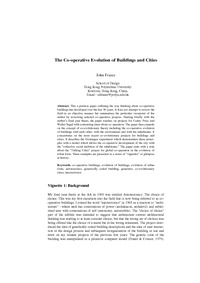The Co-operative Evolution of Buildings and CitiesJohn H. Frazer
Publikationsdatum:
Zu finden in: Cooperative Buildings: Integrating Information, Organization, and Architecture (Seite 130 bis 141), 1998
|
 |
 Diese Seite wurde seit 4 Jahren inhaltlich nicht mehr aktualisiert.
Unter Umständen ist sie nicht mehr aktuell.
Diese Seite wurde seit 4 Jahren inhaltlich nicht mehr aktualisiert.
Unter Umständen ist sie nicht mehr aktuell.
 Zusammenfassungen
Zusammenfassungen
This a position paper outlining the way thinking about co-operative buildings has developed over the last 30 years. It does
not attempt to review the field in an objective manner but summarises the particular viewpoint of the author by reviewing
selected co-operative projects. Starting briefly with the author’s final year thesis, the paper touches on projects for Cedric
Price and Walter Segal with contrasting ideas about co-operation. The paper then expands on the concept of co-evolutionary
theory including the co-operative evolution of buildings with each other, with the environment and with the inhabitants. It
concentrates on the most recent co-evolutionary projects for buildings and cities. It describes the Groningen experiment which
demonstrates these principles with a model which allows the co-operative development of the city with the “collective social
ambition of the inhabitants.” The paper ends with a note about the “Talking Cities” project for global co-operation in the
evolution of urban form. These examples are presented as a series of “vignettes” or glimpsas at history.
Von John H. Frazer im Konferenz-Band Cooperative Buildings: Integrating Information, Organization, and Architecture im Text The Co-operative Evolution of Buildings and Cities (1998)  Dieses Konferenz-Paper erwähnt ...
Dieses Konferenz-Paper erwähnt ...
 Begriffe KB IB clear | CyberspaceCyberspace |
 Volltext dieses Dokuments
Volltext dieses Dokuments
 |  The Co-operative Evolution of Buildings and Cities: Artikel als Volltext bei Springerlink ( The Co-operative Evolution of Buildings and Cities: Artikel als Volltext bei Springerlink ( : :  , 57 kByte; , 57 kByte;  : :  Link unterbrochen? Letzte Überprüfung: 2021-03-21 Letzte erfolgreiche Überprüfung: 2019-10-11) Link unterbrochen? Letzte Überprüfung: 2021-03-21 Letzte erfolgreiche Überprüfung: 2019-10-11) |
 Anderswo suchen
Anderswo suchen 
 Beat und dieses Konferenz-Paper
Beat und dieses Konferenz-Paper
Beat hat Dieses Konferenz-Paper während seiner Zeit am Institut für Medien und Schule (IMS) ins Biblionetz aufgenommen. Beat besitzt kein physisches, aber ein digitales Exemplar. Eine digitale Version ist auf dem Internet verfügbar (s.o.). Aufgrund der wenigen Einträge im Biblionetz scheint er es nicht wirklich gelesen zu haben. Es gibt bisher auch nur wenige Objekte im Biblionetz, die dieses Werk zitieren.









 Biblionetz-History
Biblionetz-History